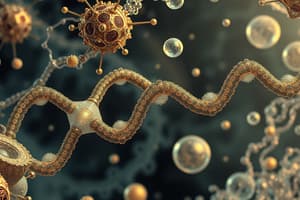Podcast
Questions and Answers
What does the symbol $K_M$ represent in the Michaelis-Menten equation?
What does the symbol $K_M$ represent in the Michaelis-Menten equation?
- Time taken for the reaction to complete
- Substrate concentration at half-maximal velocity (correct)
- Maximum substrate concentration
- Rate constant for the enzyme-substrate complex
In the reaction mechanism, what does the symbol ES represent?
In the reaction mechanism, what does the symbol ES represent?
- Enzyme-State complex
- Enzyme-Substrate complex (correct)
- Enzyme-Specificity complex
- Enzyme-Product complex
What happens to the reaction velocity as substrate concentration increases?
What happens to the reaction velocity as substrate concentration increases?
- It fluctuates randomly
- It increases linearly without bound
- It decreases exponentially
- It becomes constant at $V_{max}$ (correct)
A high value of $K_M$ indicates what about the enzyme’s affinity for the substrate?
A high value of $K_M$ indicates what about the enzyme’s affinity for the substrate?
Which rate constant corresponds to the formation of the product from the enzyme-substrate complex?
Which rate constant corresponds to the formation of the product from the enzyme-substrate complex?
What does a low value of $K_M$ signify about an enzyme's catalytic activity?
What does a low value of $K_M$ signify about an enzyme's catalytic activity?
What does the Michaelis-Menten equation help to describe?
What does the Michaelis-Menten equation help to describe?
What does the symbol 'E' represent in the enzyme catalyzed reaction?
What does the symbol 'E' represent in the enzyme catalyzed reaction?
In the steady-state assumption, what happens to the enzyme-substrate complex (ES)?
In the steady-state assumption, what happens to the enzyme-substrate complex (ES)?
What does the Michaelis-Menten constant (Km) signify?
What does the Michaelis-Menten constant (Km) signify?
Which statement correctly describes the velocity of the reaction at high substrate concentrations?
Which statement correctly describes the velocity of the reaction at high substrate concentrations?
Which rate constant in the enzyme reaction limits the overall reaction rate?
Which rate constant in the enzyme reaction limits the overall reaction rate?
What does the Michaelis-Menten equation express?
What does the Michaelis-Menten equation express?
Which of the following statements about substrate concentration and reaction rate at low concentrations is true?
Which of the following statements about substrate concentration and reaction rate at low concentrations is true?
In the equation $K_m = \frac{k_{-1} + k_{cat}}{k_1}$, what does the numerator represent?
In the equation $K_m = \frac{k_{-1} + k_{cat}}{k_1}$, what does the numerator represent?
What occurs when more active sites are occupied in an enzyme-catalyzed reaction?
What occurs when more active sites are occupied in an enzyme-catalyzed reaction?
What do the symbols $k_{1}$, $k_{2}$, and $k_{3}$ represent in the enzyme-catalyzed reaction?
What do the symbols $k_{1}$, $k_{2}$, and $k_{3}$ represent in the enzyme-catalyzed reaction?
Which statement accurately describes the steady state in an enzyme-catalyzed reaction?
Which statement accurately describes the steady state in an enzyme-catalyzed reaction?
What occurs during the pre-steady state of an enzyme-catalyzed reaction?
What occurs during the pre-steady state of an enzyme-catalyzed reaction?
Which component of the enzyme-catalyzed reaction is released unchanged?
Which component of the enzyme-catalyzed reaction is released unchanged?
Which graph characteristic indicates the steady state during the enzyme-catalyzed reaction?
Which graph characteristic indicates the steady state during the enzyme-catalyzed reaction?
How does the rate of the overall reaction relate to the breakdown of the ES complex?
How does the rate of the overall reaction relate to the breakdown of the ES complex?
What happens to the concentration of the enzyme-substrate complex (ES) at steady state?
What happens to the concentration of the enzyme-substrate complex (ES) at steady state?
What role does the substrate (S) play in the enzyme-catalyzed reaction?
What role does the substrate (S) play in the enzyme-catalyzed reaction?
What happens to the enzyme concentration ([E]) during the enzyme-catalyzed reaction?
What happens to the enzyme concentration ([E]) during the enzyme-catalyzed reaction?
Flashcards
Michaelis-Menten Equation
Michaelis-Menten Equation
Equation describing the relationship between reaction velocity (v) and substrate concentration ([S]) in an enzyme-catalyzed reaction.
Vmax
Vmax
Maximum velocity of an enzyme-catalyzed reaction; the theoretical fastest rate.
KM
KM
Michaelis constant; substrate concentration at which the reaction velocity is half of Vmax. Shows how well the enzyme binds to a substrate.
High KM
High KM
Signup and view all the flashcards
Low KM
Low KM
Signup and view all the flashcards
Enzyme-Substrate Complex (ES)
Enzyme-Substrate Complex (ES)
Signup and view all the flashcards
Reaction Velocity (v)
Reaction Velocity (v)
Signup and view all the flashcards
Enzyme-catalyzed reaction
Enzyme-catalyzed reaction
Signup and view all the flashcards
Steady-state assumption
Steady-state assumption
Signup and view all the flashcards
Michaelis-Menten constant
Michaelis-Menten constant
Signup and view all the flashcards
Pre-steady state
Pre-steady state
Signup and view all the flashcards
Steady state
Steady state
Signup and view all the flashcards
Substrate (S)
Substrate (S)
Signup and view all the flashcards
Product (P)
Product (P)
Signup and view all the flashcards
Enzyme (E)
Enzyme (E)
Signup and view all the flashcards
Michaelis-Menten constant (Km)
Michaelis-Menten constant (Km)
Signup and view all the flashcards
What is the Michaelis-Menten equation?
What is the Michaelis-Menten equation?
Signup and view all the flashcards
Why is the kcat value important?
Why is the kcat value important?
Signup and view all the flashcards
Study Notes
Enzyme Catalyzed Reaction
- Enzyme (E) and substrate (S) interact to form an enzyme-substrate complex (ES)
- The ES complex breaks down to yield the product (P) and the free enzyme (E)
- The reaction occurs in a series of steps which can occur at different rates
- The slowest step determines the overall reaction rate
- The ES complex is formed rapidly compared to its breakdown
- The slower second reaction must limit the rate of the overall reaction
Michaelis-Menten Equation
- Describes the velocity of an enzymatic reaction
- At saturation, velocity (v) = maximum velocity (Vmax)
- Km = Michaelis-Menten constant
- Km = [S] at ½ Vmax
- A high Km means the enzyme has a low affinity for the substrate
- A low Km means the enzyme has a high affinity for the substrate
Graph
- The graph shows the relationship between reaction velocity and substrate concentration
- The curve starts slow and gradually increases then plateaus
- The curve approaches a maximum velocity (Vmax) as the substrate concentration increases
- The Km is the substrate concentration that produces half the maximum velocity
Studying That Suits You
Use AI to generate personalized quizzes and flashcards to suit your learning preferences.




